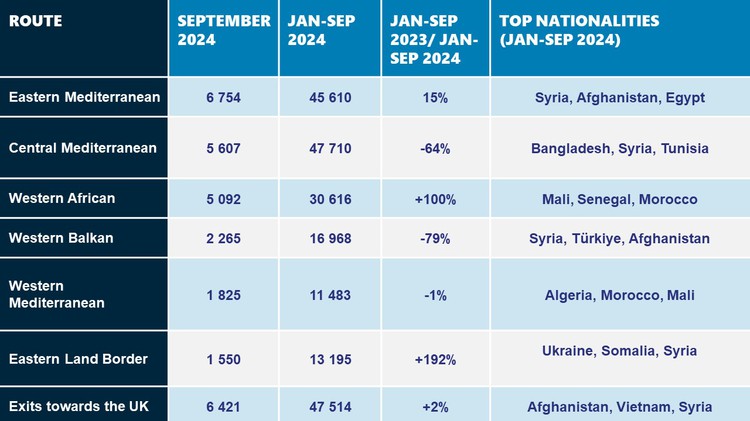The number of
irregular border crossings into the European Union fell by 42% to 166 000 in
the first nine months of this year, according to preliminary data collected by
Frontex.*
The most
significant declines in irregular border crossings were observed on the Western
Balkan and Central Mediterranean routes, with a 79% and 64% decline,
respectively.
Over 3 000 Frontex
officers and staff are deployed across Europe
to help manage the EU’s external borders.
Key highlights
for the first nine months of 2024:
- Central Mediterranean recorded a 64% drop
(y/y) in irregular border crossings.
- Western Balkans region demonstrated a
significant decline of 79%.
- Eastern Land Border and Western African
route saw the highest increases, at 192% and 100%, respectively.
- Top three nationalities so far this year:
Syria, Mali, Ukraine.
The Central
Mediterranean route continued its significant downward trend this year.
Between January and September, the number of arrivals on this route fell by 64%
to 47 700.
The Eastern
Mediterranean, which has continued to rise this year, saw an increase of
15% in the first nine months of the year to 45 600. In September, this
was the busiest route with the highest number of detections at 6 750, compared
with 5 600 detections in the Central Mediterranean.
The number of detections
on the Western African route remained exceptionally high in the
January-September period, reaching over 30 600, double the figure from the same
period of last year.
The number of
detections in the Western Balkan route recorded the biggest drop of all
the main migratory routes to the EU this year with the fall of 79% to nearly 17
000.
With an increase of
192% to 13 200, the Eastern Land Borders continued to record high
numbers of arrivals this year.
On the Channel
route, the number of detections between January and September increased by 2%
to reach 47 514.
* Note: The
preliminary data presented in this statement refer to the number of detections
of irregular border crossing at the external borders of the European Union. The
same person may cross the border several times in different locations at the
external border.

